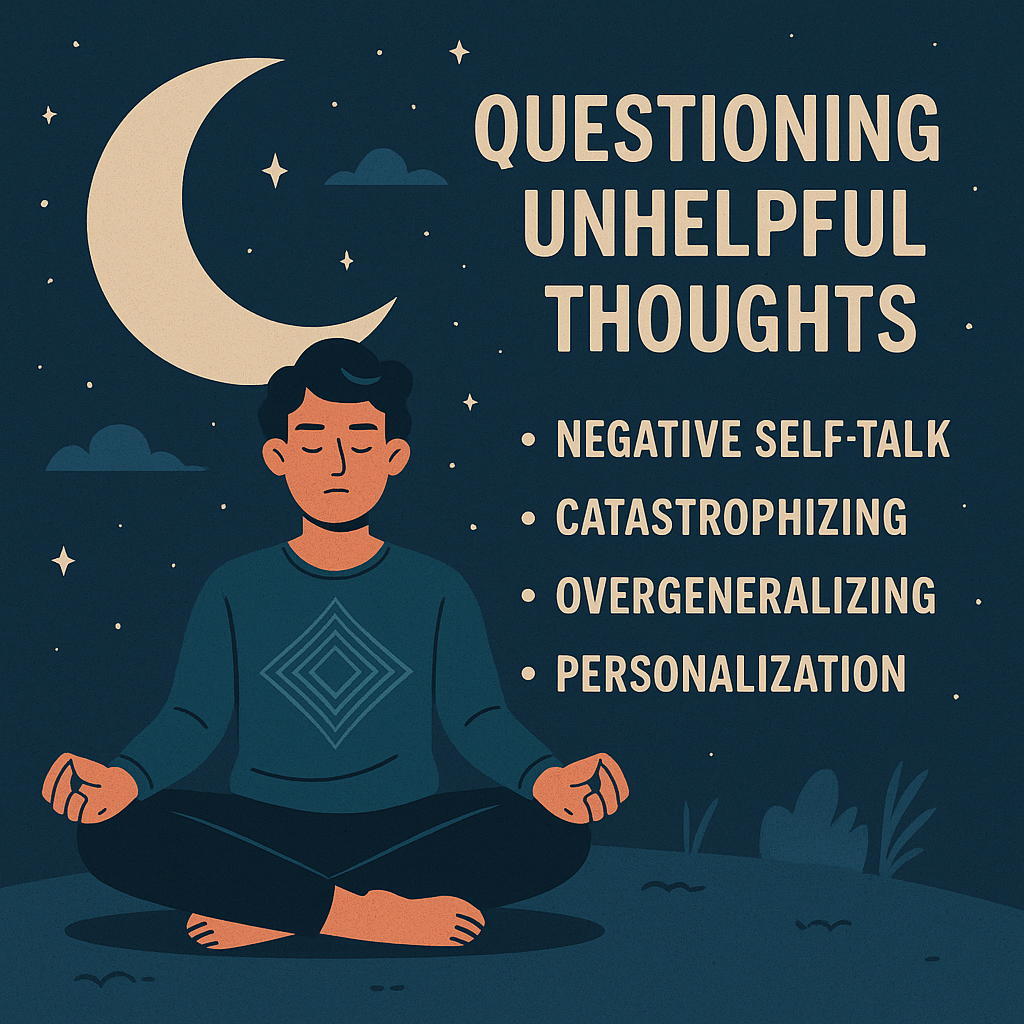Questioning and challenging unhelpful thoughts for a better mindset
This blog teaches readers how to recognize, challenge, and ultimately transform negative thought patterns like catastrophizing, personalization, and negative self-talk. Through simple awareness exercises, inner child work, and the practice of naming emotions, it offers readers tools to develop a more resilient, calm, and present mindset.
Our mindset, the compass guiding our journey in this thing we call life, holds the key to unlocking a world of possibilities. Good and bad.
When life throws challenges it can impact your mindset and cause negative thoughts and downward spirals. Some of these spirals can lead to depressive states. But they don’t always have to.
By embracing the practice of mind meditation and challenging unhelpful thoughts, we embark on a journey of self-discovery and empowerment.
Through exercises to stop negative thinking and cultivating positive thought patterns, we transcend the shackles of negative self-talk, forging a path towards a healthier, more resilient mind.
A path where your mind is no longer attacking you with negative thoughts but aiding you with loving ones.
The downward spiral can be reversed to an upward one at any given time. You have that power even if it doesn’t seem like it in the moment.
Related: More on Negative Thought Loops and Core Beliefs.
The power of questioning your thoughts
Delving deeper, we unravel the intricate interplay between our thoughts, emotions, and behaviors, recognizing the profound impact they wield over our overall well-being.
Through the power of questioning our thoughts, we invite a shift in perspective, moving beyond the confines of subjective perception towards a more objective understanding of ourselves and the world around us.
In other words, we can create somewhat of a respite from our chatterbox of a mind. Even if it’s only for a second, that’s a large enough gap to work with to implement strategies that may help you gain control over your mind (and life) once and for all.
‘Seeing’ the one-second gap can be enough to change your whole mindset.
Let’s try this exercise to gain a better understanding of what we mean:
Close your eyes and think of a time that you were especially triggered, it could be regarding anything.
Really try to feel yourself back in that very moment. Feel the negative emotion(s) rise – when the emotions arise, name them! See the emotion. Recognise it and claim authority over it.
Let’s say the emotion you feel/felt was anger, say out loud, ‘This makes me feel angry’.
Do you notice anything happening when you name what you feel?
Take a moment to think about it. If you haven’t already, then go back over the exercise and try it for yourself. See if anything happens as soon as you recognise and acknowledge the emotion.
Sometimes what happens is the emotion becomes ‘neutralized’. Noticing it may well be enough to claim power over it.
Now, this exercise is from a memory so the emotion has less power over us but what we are trying to do is cultivate that one second gap habit, that chance of stopping the anger or the rage or the jealousy or the you-name-it negative emotion in order to control it better when it is in the heat of the moment.
These exercises can go much deeper. For instance, at this moment you may not know why you have a particular trigger, why the anger arises in the first place, but that’s really where therapy comes in – to find out where that comes from.
Once we understand where those emotions come from, we can start to pinpoint that particular moment and focus the exercises there. Turning negative thought patterns into positive ones.
What are some common negative thought patterns to question?

There are many ways in which we may be negative towards ourselves. Here are some common thought patterns.
Negative self-talk:
The silent saboteur whispering doubts and criticisms, negative self-talk can erode our self-esteem and confidence if left unchecked. By recognizing and challenging negative self-talk, we reclaim control over our inner narrative, replacing self-doubt with self-compassion and encouragement.
Catastrophizing:
Another treacherous path our minds may wander is catastrophizing, where minor setbacks morph into catastrophic disasters in the blink of an eye. By honing our awareness, we can identify when we’re sliding down this slippery slope, pausing to evaluate the situation objectively and challenge the validity of our catastrophic predictions.
Through this practice, we cultivate resilience in the face of adversity, embracing a more balanced perspective grounded in reality.
Overgeneralizing:
Overgeneralization can lead us astray, blurring the lines between isolated incidents and overarching truths. When we catch ourselves making sweeping generalizations based on limited evidence, it’s crucial to pause and examine the validity of our assumptions.
Personalization:
Personalization can cloud our judgment, causing us to internalize external events or behaviors that may have little to do with us. By recognizing when we’re taking things personally that aren’t necessarily about us, we liberate ourselves from unnecessary burdens and misunderstandings.
Identifying (naming) these thought patterns as they emerge enables you to pause and reflect before emotions overwhelm you. While mastering this practice may seem daunting at first, with persistence, you can reach a stage where you confidently navigate your emotions, asserting control over them.
For further insights on managing emotions, I encourage you to explore Byron Katie’s invaluable resource, “The Work.” These practical worksheets offer strategies to enhance mindfulness in every moment, facilitating the cultivation of self-control.
Some Practical Tips
If you are having issues with any of the above, then the likelihood is you have trauma, this trauma is triggering you in certain situations, and it’s likely ruining parts of your life and/or relationships.
Seeking therapy/help can help determine the exact trauma to which you are responding to.
Counselors specialize in this and can even help with your relationships. Contact us here for individual help.
Once the trauma has been established with the help of a professional, you can try this:
Related: Self-Administered EMDR
Go back to the moment of your trauma – this is likely to be in childhood but not necessarily. For the sake of this exercise let’s say it’s a childhood trauma.
Picture yourself as you are now in the moment of your traumatic event, picture yourself overlooking little you in that instance.
I want you to go up to little you and tell yourself that everything is going to be ok. Picture yourself embracing little you with a nice warm, caring hug. This can take as long as you want it to and will likely work better with your eyes closed.
Tell little you that you know you are feeling scared, angry, hurt (whatever emotion little you felt at the time of that trauma aka name it) and that little you doesn’t have to feel that way anymore.
Before you leave the situation in your mind’s eye, try to feel and name the complete opposite emotion to the negative one you felt at the time. So instead of anger you feel calm, instead of fear or anxiety you feel courageous or strong.
You can repeat this exercise as many times as you want for many different traumas you may have.
The purpose of this is to try to trick your body and mind that actually everything is ok and your triggers no longer need to try to protect you…
Eckhart Tolle coined the term “pain body” to describe the accumulation of emotional pain and negative energy stored within an individual’s psyche. According to Tolle, the pain body consists of unresolved emotions, traumas, and past experiences that linger in the subconscious mind and influence one’s thoughts, behaviors, and reactions.
When triggered by external events or memories, the pain body can become activated, causing a surge of negative emotions such as anger, fear, or sadness. This activation can lead to destructive patterns of behavior and contribute to suffering and unhappiness.
Hopefully, these types of exercises can help heal that trauma so your ‘pain-body’ no longer needs to be activated.
We’ve created a page called Guru Guides, where you can explore brief insights into various spiritual gurus — both past and present — and even cast a vote for your favorite.
Conclusion
In the intricate dance of our thoughts lies the blueprint of our reality, shaping our emotions, actions, and ultimately, our lives. Yet, amidst the chaos of daily existence, it’s easy to become ensnared in negative thought patterns, unwittingly surrendering our power to the relentless chatter of our minds. But it doesn’t have to be this way.
By embracing the transformative power of questioning our thoughts, we unlock a gateway to liberation and self-mastery. Through the simple act of pausing to challenge the validity of our thoughts, we invite a shift in perspective, illuminating the path towards a more objective understanding of ourselves and the world around us. By identifying our emotions, we reclaim sovereignty over our inner narrative, replacing self-doubt with self-compassion, and fear with resilience.
Recommended products
I want to leave you with this –
I want you to take a look around at your surroundings, take things in, name them even. Window, wall, door, light, laptop – really look at what you are looking at. Doing this allows you to become aware at a basic level and is something that can be done throughout the day.
When you are seeing what is right in front of you, you are helping your mind be present in the moment.
Congratulations you just became aware; the more you can do this the easier it will become to question and name those negative thoughts as soon as they arise. Good luck.






